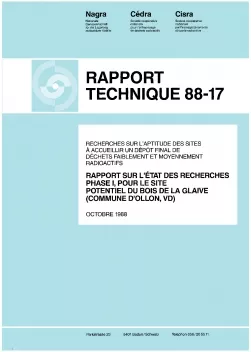
Rapport Technique NTB 88-17
Recherches sur l'aptitude des sites à accueillir un dépôt final de déchets faiblement et moyennement radioactifsRapport sur l'état des recherches Phase 1, pour le site potentiel du Bois de la Glaive (Commune d'Ollon, VD)
On 30th September 1985, site suitability investigations with a view to disposal of low- and intermediate-level radioactive waste were licensed by the Federal Government at three locations –Bois de la Glaive (Canton Vaud), Oberbauenstock (Canton Uri) and Piz Pian Grand (Canton Graubünden). This report presents the status of the investigations at Bois de la Glaive as at the end of 1987 and discusses the results of the programme.
The investigations planned for Bois de la Glaive were outlined in the programme report NTB 86-16 and were aimed primarily at determining the geometry of the anhydrite host rock, i.e. locating the position of its upper boundary with the so-called gypsum cap and of its lower boundary. The large extent of the anhydrite formation predicted by Nagra formed the basis for selecting Bois de la Glaive as a potential site but was disputed by the experts from the community of Ollon. The investigations started with detailed geological surface mapping of the area of interest and this provided the basis for future work.
Because of the opposition at Ollon, none of the investigations subject to authorization have been carried out, even though these investigations had been approved by the Federal Government on 30th September 1985. Nevertheless, various investigations not requiring a licence have provided a considerable store of data. The details of the work actually carried out are as follows: (i) Detailed geological mapping of the earth is surface over an area of 22.5 km2 on a scale of 1:5000. This study included the first geological recording of the Galerie de Salin (Salin drift) which formed part of an 18th-century mine. (ii) The existing hydrogeological data on the area were compiled and provided a first impression of the overall hydrogeological conditions. (iii) The provisional concept of a possible repository at Bois de la Glaive and of the corresponding exploration gallery was elaborated under the point of view of civil engineering and the long-term behaviour of the host rock was assessed qualitatively.
The geological investigations carried out between 1984 and 1987 confirm the existence of a relatively extensive gypsum-anhydrite formation at Bois de la Glaive and support the assumption that, beneath the 20 to 40 m thick gypsum cover, the anhydrite probably extends several hundred metres in a vertical direction. The results of the investigations also justify the assumption that the anhydrite at Bois de la Glaive is relatively homogeneous with a small proportion of lenses of accompanying rock (with small dimensions) and a low occurrence of fractures. The presence of tectonic lenses of extraneous rock is also unlikely.
From a hydrogeological point of view, it has been confirmed that the northern, western, southern and upper boundaries of the host rock are permeable formations. Given the present state of knowledge, it is not possible to predict the (hydro)geological conditions underlying the anhydrite. Because of its homogeneity, the host rock itself is practically impermeable.
The concomitant studies of the long-term behaviour of the anhydrite have shown that, with respect to waste material, the following two release scenarios are relevant and, if the pertinent geological situation is present, critical: (i) Radionuclide transport with deep groundwater along wedges of extraneous rock; (ii) Migration of the anhydrite-gypsum contact surface and associated karstification.
To summarise, based on the present stage of the investigations and on rock- resp. site-specific knowledge of the anhydrite as a host rock, there are no real reasons for ruling out the site. The results of the investigations have put Nagra in the position of being able to submit to the Federal Government a request for licensing of an exploratory drift and related investigations of the host rock also at the potential site of Bois de la Glaive. The investigations carried out up till now have shown clearly that, before construction of the drift is embarked upon, the field studies outlined in the investigation programme NTB 86-16 have to be carried out, at least to some extent, in order to improve the present state of knowledge.
